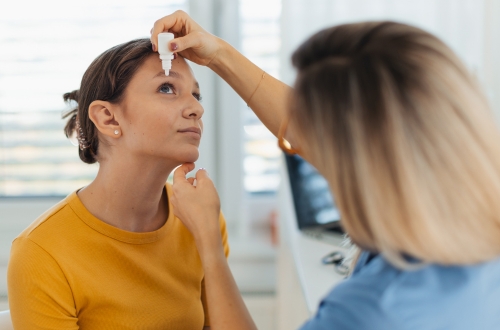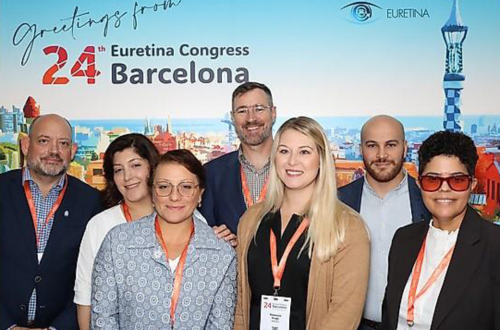Empowering the Visually Impaired: Assistive Technologies and Education
Every year, the second Thursday of October marks World Sight Day, a day in the field of ophthalmology dedicated to raising awareness about visual impairment and blindness, while emphasizing the importance of taking care of our vision. On October 10, the World Health Organization (WHO) commemorated World Sight Day by making children’s eye health the focus of their 2024 campaign. Globally, over 450 million children have sight problems that require treatment. The International Agency for the Prevention of Blindness (IAPB) recognizes the detrimental effect of uncorrected vision impairment in children’s education, but something as simple as providing prescription eyeglasses can reduce failing rates within schools by 44%. In partnership with WHO, the IAPB is running the 2024 Love Your Eyes campaign to inspire schools, organizations, and families to participate in the Global Challenge by screening for vision health in their children.
Earlier this year in May, WHO also launched their global SPECS 2030 initiative to ensure easy accessibility of affordable, quality eyeglasses, as well as to reduce stigma around requiring vision corrective devices like spectacles. TFS HealthScience’s Ophthalmology CRO (Contract Research Organization) is joining this year’s efforts by raising awareness about the role of these devices in empowering those with visual impairments. In this article, we will discuss key innovative assistive technologies and educational strategies that have vastly improved accessibility, independence, and quality of life in individuals whose sight is impaired. Read on to learn more!
Empowering the Visually Impaired with Innovative Visual Assistive Technologies
The WHO estimated there were at least 2.2 billion people worldwide experiencing vision impairment, ranging from partial vision loss to complete blindness. The concerning reality is that, in 1 million of these cases, impaired vision could have been prevented if it had been addressed early on. These statistics demonstrate why we need effective solutions to improve sight in this patient population. With the rise of technological capabilities and advancements in recent years, the ophthalmology therapeutic area has seen numerous assistive devices emerge to help visually impaired people interact more freely with the world around them.
1. Screen Readers and Voice Assistants
There are two popular screen readers that have been developed to help those with visual impairments or blindness navigate digital interfaces. The first is NVDA (NonVisual Desktop Access), which is an open access and free tool that also has features like Braille support, speech synthesizers, and customizable keystrokes. The second is JAWS (Job Access With Speech), a commercially available screen reader similar to NVDA, except it also enables users to access photos, PDFs, and a built-in speech recognition system.
Voice assistants like Siri, Alexa, and Google Assistant offered widely through our smartphones have also become incredibly sophisticated. These voice assistants allow users to have hands-free control over tasks like navigation control, setting reminders, or even controlling compatible smart home devices. Information (e.g., asking what the weather is today) is also easily accessed through voice commands.
Visit this article to learn more about how artificial intelligence (AI) is helping empower the visually impaired.
2. Wearable Devices
There have been impressive advancements in wearable devices that offer innovative solutions for the visually impaired. For example, OrCam MyEye is an assistive tool that attaches to a pair of eyeglasses and can get text read to you from any book or screen, recognize faces, and accurately identify products. It also offers a smart magnifier that enables easy zooming, adjustable contrast, and the user to ask questions interactively to access more information.
eSight Go is another similar wearable device that was developed to serve as an assistive technology for people with low vision. It is a pair of glasses with a built-in camera and clinically validated algorithms that capture and enhance incoming images for the user. These images are then projected onto each of the two OLED screens of the eyeglasses in real-time. The brain is then able to better process this visual information and see with greater clarity.
3. Braille Technology
Traditional braille is still as important as ever for helping people who are visually impaired access information readily. However, there are now refreshable electronic Braille displays that enable access to digital content. This dynamic Braille technology represents the text on a computer or smartphone screen as the cursor is moved across the screen, allowing users to access digital information in real-time.
Visit this publication by Senjam et al. (2021) to learn about other digital content accessibility features in smartphone-based assistive technology for the visually impaired.
4. Navigation and Mobility Aids
Certain navigation apps have also been designed specifically to help individuals with visual impairment with navigating their surroundings, indoors and outdoors. For example, BlindSquare is an accessible GPS app that works by determining the user’s location to learn what is nearby and provide detailed audio descriptions of surroundings and turn-by-turn directions when navigating. Emerging research is also coming out about laser sensing and vision sensing smart canes for the visually impaired, but these systems require further development before they can be widely used commercially.
Empowering the Visually Impaired by Promoting Education and Skill Development
No doubt technology plays a crucial role in improving the quality of life of people with sight problems, but educational and skill development initiatives at the institutional level are equally important in empowering this population. The following specialized educational programs and training opportunities are considered vital for equipping visually impaired individuals, especially children and teens, with the essential tools and knowledge they need to thrive.
1. Inclusive Education in Mainstream School Environments
Countries around the world are increasingly adopting inclusive education policies that allow children and students with visual impairment to be included in mainstream classrooms. For example, this 2022 paper by Amponsah and Bekele explores how online learning can be used by universities to better accommodate visually impaired students. Other strategies that can be adapted into teaching methods include providing materials in accessible formats (large print, Braille, or audio), using tactile learning models, and incorporating more descriptive language.
By making their environments more inclusive for those with vision problems, educational institutions can provide equitable learning opportunities for these students, as well as help foster better social integration and compassion among classmates who are sighted.
2. Specialized Training Programs and Other Resources
There are many specialized training programs and dedicated resources offered worldwide that help empower the visually impaired by teaching a wide range of key skills:
- The non-profit organization, Vision-Aid, offers several subsidized or no-fee computer training programs for blind and low-vision students.
- The Perkins School for the Blind works with global partners to make educational and digital content accessible to blind and visually impaired individuals.
- The American Printing House for the Blind (APH) is a non-profit that has existed since 1858 and has a wide variety of assistive programs:
- The Vision Aware program helps teach independent living skills.
- The Family Connect program provides parents and families with information about educational options and support groups.
- The Career Connect program provides career guidance and access to mentorship opportunities.
- The American Foundation for the Blind (AFB) aims to expand employment opportunities for individuals who are blind or visually impaired by advocating to business leaders, public officials, and policymakers.
Other skills taught by these organizations and more may include orientation and mobility training, Braille literacy, educational tutoring, as well as job readiness. Implementing these kinds of programs empower individuals living with blindness or low vision to lead independent lives and pursue their career aspirations.
3. Using Assistive Technologies to Make Pursuing STEM Education Possible
Recently, there have been efforts to make Science, Technology, Engineering, and Mathematics (STEM) education accessible to visually impaired students. This 2023 paper published in Nature explores how the curriculum for chemistry can be made more accessible for these students. Among the strategies mentioned were using tactile stickers to label different sizes and shapes of laboratory tools, audio technology implemented into thermometers and weighing scales, plastic pipettes with tactile notches at each volume mark, and many others.
For other subjects, 3D-printing can visually model scientific concepts with tactile diagrams and coding platforms can be made more accessible. Traditionally, visually impaired students have faced difficulty pursuing STEM studies due to inaccessible learning accommodations. However, innovative approaches to make these subjects more inclusive can open up exciting new educational and career possibilities.
Conclusion
In conclusion, the landscape of assistive technologies and educational initiatives for the visually impaired is rapidly evolving to improve accessibility. From advanced screen readers and wearable devices to specialized educational programs and STEM accessibility efforts, there is a growing number of support resources to help individuals with visual impairment lead independent, fulfilling lives. As the available technology advances further with time, these devices and educational programs are expected to become gradually more affordable and widespread, creating a more equitable world for people with all levels of sight. With the passing of this year’s World Sight Day, join the IAPB and WHO in their efforts as they empower visually impaired individuals to reach their full potential and contribute their unique perspectives worldwide.
TFS CRO: Your Industry Partner in Ophthalmology
TFS HealthScience is a global CRO pioneering the future of ophthalmology clinical research. The Ophthalmology CRO team at TFS has amassed an impressive track record, including over 70 clinical trials conducted in more than 30 countries across 10 ophthalmology indications with nearly 5,000 participating patients in the last five years. Our global expertise and high-quality clinical development services have established the company as a trusted partner for clinical trials in any country across several therapeutic indications in ophthalmology.
When you choose TFS HealthScience Ophthalmology CRO as your partner, you’re choosing passion, quality, and a trustful collaboration. To learn more about the data-driven solutions and expertise TFS HealthScience CRO can offer for your next clinical trial, click here. Connect with TFS HealthScience CRO on LinkedIn or speak with a TFS representative here today!
Interested in more ophthalmology content from us? Visit the TFS Intellect Hub for more resources, like articles, case studies, white papers, and more!
Connect with Us
Contact us today to discover how TFS can be your strategic CRO partner in clinical development.


